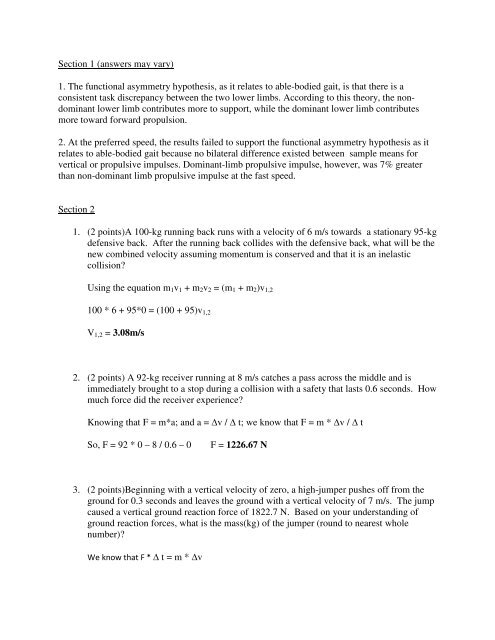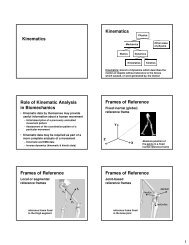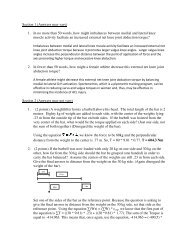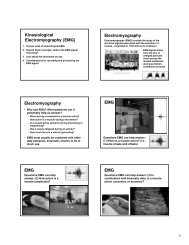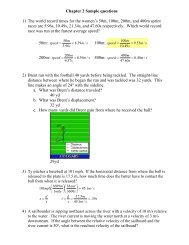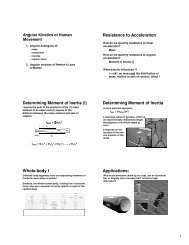Section 1 (answers may vary) 1. The functional asymmetry ...
Section 1 (answers may vary) 1. The functional asymmetry ...
Section 1 (answers may vary) 1. The functional asymmetry ...
You also want an ePaper? Increase the reach of your titles
YUMPU automatically turns print PDFs into web optimized ePapers that Google loves.
<strong>Section</strong> 1 (<strong>answers</strong> <strong>may</strong> <strong>vary</strong>)<br />
<strong>1.</strong> <strong>The</strong> <strong>functional</strong> <strong>asymmetry</strong> hypothesis, as it relates to able-bodied gait, is that there is a<br />
consistent task discrepancy between the two lower limbs. According to this theory, the nondominant<br />
lower limb contributes more to support, while the dominant lower limb contributes<br />
more toward forward propulsion.<br />
2. At the preferred speed, the results failed to support the <strong>functional</strong> <strong>asymmetry</strong> hypothesis as it<br />
relates to able-bodied gait because no bilateral difference existed between sample means for<br />
vertical or propulsive impulses. Dominant-limb propulsive impulse, however, was 7% greater<br />
than non-dominant limb propulsive impulse at the fast speed.<br />
<strong>Section</strong> 2<br />
<strong>1.</strong> (2 points)A 100-kg running back runs with a velocity of 6 m/s towards a stationary 95-kg<br />
defensive back. After the running back collides with the defensive back, what will be the<br />
new combined velocity assuming momentum is conserved and that it is an inelastic<br />
collision<br />
Using the equation m 1 v 1 + m 2 v 2 = (m 1 + m 2 )v 1,2<br />
100 * 6 + 95*0 = (100 + 95)v 1,2<br />
V 1,2 = 3.08m/s<br />
2. (2 points) A 92-kg receiver running at 8 m/s catches a pass across the middle and is<br />
immediately brought to a stop during a collision with a safety that lasts 0.6 seconds. How<br />
much force did the receiver experience<br />
Knowing that F = m*a; and a = ∆v / ∆ t; we know that F = m * ∆v / ∆ t<br />
So, F = 92 * 0 – 8 / 0.6 – 0<br />
F = 1226.67 N<br />
3. (2 points)Beginning with a vertical velocity of zero, a high-jumper pushes off from the<br />
ground for 0.3 seconds and leaves the ground with a vertical velocity of 7 m/s. <strong>The</strong> jump<br />
caused a vertical ground reaction force of 1822.7 N. Based on your understanding of<br />
ground reaction forces, what is the mass(kg) of the jumper (round to nearest whole<br />
number)<br />
We know that F * ∆ t = m * ∆v
Because body weight is also a vertical force, it too needs to be a part of the equation.<br />
Meaning the sum of the forces is the ground reaction force (GRF) plus the person’s body<br />
weight.<br />
So, ((1822.7 + m(-9.81)) * 0.3 = m * 7<br />
Solving for m, we get<br />
546.81 + -2.943m = 7m<br />
546.81 = 9.943m<br />
m = 55 kg


